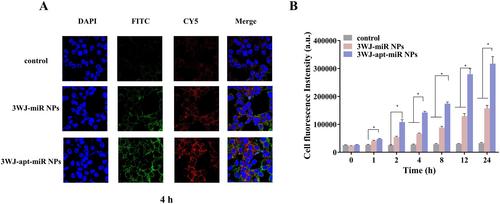Preparation, characterisation, and in vitro cancer-suppression function of RNA nanoparticles carrying miR-301b-3p Inhibitor
Abstract
Background
Multidrug resistance is the biggest barrier on the way to chemotherapy for lung adenocarcinoma (LUAD). For some LUAD patients with cisplatin (DDP) resistance and poor prognoses, the authors put forward RNA nanoparticles (NPs) carrying miR-301b-3p Inhibitor.
Methods
The NPs were composed of miR-301b-3p, A549 aptamer (A549apt), and Cyanine 5 in a bottom-up manner with a 3-way-junction (3WJ) structure. Diameter, assembly process, and morphology of NPs were observed by Dynamic Light Scattering, Native-Polyacrylamide Gel Electrophoresis, and Atomic Force Microscopy. Cell internalisation, toxicity, proliferation, migration, invasion, and apoptosis were assayed by confocal laser scanning microscope, CCK8, colony formation assay, Transwell, western blot, and flow cytometry.
Results
3WJ-apt-miR was evenly distributed, with diameter of 19.61 ± 0.49 nm and triangular branching structures. The accurate delivery of this NP in vivo was ensured by A549 aptamer featuring specific targeting, with smaller side effects than traditional chemotherapy. Such nanomaterials were effectively internalized by cancer cells, with normal cell activity intact. Cancer cell proliferation, invasion, and migration were suppressed, and DDP sensitivity was enhanced, causing DNA damage and facilitating apoptosis of DDP-resistant cells.
Conclusion
Based on RNA self-assembling, the authors researched the effect of miRNA on DDP sensitivity in LUAD regarding gene regulation. 3WJ-apt-miR paves the way for clinical tumour therapy.


 求助内容:
求助内容: 应助结果提醒方式:
应助结果提醒方式:


